Eyemouth Primary – Where Play Lives at the Heart of the Community
Written by Fiona Kirkland, Play Pedagogy Project Officer
My recent visit to Eyemouth Primary was one of those special days that reminded me exactly why play pedagogy is so important. It’s not just about making learning enjoyable; it’s about deeply embedding care, creativity, and strong relationships into everyday experiences, transforming learning into something truly meaningful. Nestled right at the heart of its community, Eyemouth Primary is a wonderful example of what can happen when thoughtful leadership, strong relationships, and a genuine commitment to play come together. With the harbour, river, local shops, and plenty of beautiful green spaces right on its doorstep, the school is ideally positioned for rich, authentic learning opportunities. It genuinely is a dream location for learning through play!
From the moment I arrived and was warmly welcomed by Mr Maunder, the head teacher, and Mrs Hiroz, the deputy head, it was clear this was a nurturing and inclusive space. Their pride in the school shines through, and rightly so.
Inside, the classrooms were creative, inviting spaces where learning and play went hand-in-hand. There were cosy reading corners, and I was especially taken with the blinds that had been transformed into a beautiful painted night sky by a very talented teacher! The use of pallets to zone spaces was clever and practical, creating extra surfaces for display and helping to define learning areas. I loved how every corner of each classroom was thoughtfully planned to make sure children felt a sense of belonging. The children themselves were chatty, friendly, and eager to tell me all about their learning, which is always a good sign of a happy, engaged classroom.
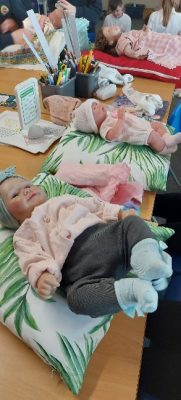 A visit to the middle school brought a whole different kind of excitement. I was slightly disappointed to have missed the real-life baby visit earlier in the day (I love a wee cuddle, and there’s nothing quite like that lovely new-baby smell!), but I still got to enjoy seeing the brilliant learning it inspired. Dolls were being cared for beautifully, and there was lots of tender nurturing going on, feeding, changing nappies, cuddles, and bedtime stories. A room full of potential future early years practitioners if you ask me!
A visit to the middle school brought a whole different kind of excitement. I was slightly disappointed to have missed the real-life baby visit earlier in the day (I love a wee cuddle, and there’s nothing quite like that lovely new-baby smell!), but I still got to enjoy seeing the brilliant learning it inspired. Dolls were being cared for beautifully, and there was lots of tender nurturing going on, feeding, changing nappies, cuddles, and bedtime stories. A room full of potential future early years practitioners if you ask me!
 Next door, a group were using air-dry clay to sculpt famous Scots, a lovely blend of art, history, and language. Their choices ranged from footballers like Willie Miller, Kenny Dalglish, and John McGinn, to singers like Amy MacDonald, and of course our most famous Scotsman, Rabbie Burns himself. It was fantastic to see children so engaged and able to explain exactly why they’d chosen each person. That’s exactly what meaningful, child-centred learning looks like, the kind of knowledge that comes from genuine engagement rather than worksheets!
Next door, a group were using air-dry clay to sculpt famous Scots, a lovely blend of art, history, and language. Their choices ranged from footballers like Willie Miller, Kenny Dalglish, and John McGinn, to singers like Amy MacDonald, and of course our most famous Scotsman, Rabbie Burns himself. It was fantastic to see children so engaged and able to explain exactly why they’d chosen each person. That’s exactly what meaningful, child-centred learning looks like, the kind of knowledge that comes from genuine engagement rather than worksheets!
One thing that stood out for me was the sensitive approach the school took to inclusion. A classroom had been carefully reorganised to ensure a child who uses a wheelchair could easily move around, access resources independently, and feel like a valued member of the class. It might seem like a small thing, but it makes a huge difference to how that child experiences their day at school. It showed clearly that the school is committed to creating a space where every single child feels welcomed, included, and supported.
The Primary 7s were off visiting the local high school, a shiny new build on the edge of town. While the new high school looks impressive, it made me appreciate even more just how special Eyemouth Primary’s location is, right in the centre of the community. It reminded me a lot of Froebel’s ideas. Froebel often took the children from his kindergarten out into their local community to build strong, real-life connections. Eyemouth Primary is doing just that. The children walk or cycle to school, visit local shops and businesses, and regularly head down to the harbour and river. They even have an ongoing relationship with the local care home, where one of the residents, now retired, used to teach Mrs Hiroz. I just love these full-circle community connections, a beautiful, living example of the cycle of life and learning.
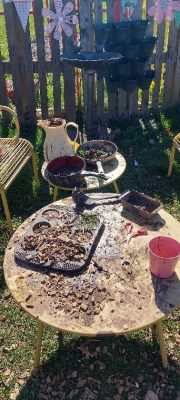 Their ELC was an absolute joy! The space is really well thought out and imaginatively resourced; they’ve made the most of every inch. There was a buzz of creativity, with children deeply engaged in their learning. I especially liked their music room with a piano, although on such a lovely afternoon, most of the children were outdoors enjoying the sunshine and fresh air. Outside, the children were fully immersed in play experiences, a fantastic example of how imagination and a good stash of loose parts can create endless possibilities. Bikes, tracks, climbing structures, growing spaces, and the ingenious “sand shed” (cat-proof and practical!) all combined to create a rich, engaging environment. I had the loveliest personal tour of the garden by one very enthusiastic child who proudly showed me all his favourite spaces. When I asked him to take me to the best place of all, he led me straight to his keyworker, who was busy reading books with children on a pallet sofa in the sunshine. A perfect reminder, if one was needed, that stories belong anywhere and everywhere!
Their ELC was an absolute joy! The space is really well thought out and imaginatively resourced; they’ve made the most of every inch. There was a buzz of creativity, with children deeply engaged in their learning. I especially liked their music room with a piano, although on such a lovely afternoon, most of the children were outdoors enjoying the sunshine and fresh air. Outside, the children were fully immersed in play experiences, a fantastic example of how imagination and a good stash of loose parts can create endless possibilities. Bikes, tracks, climbing structures, growing spaces, and the ingenious “sand shed” (cat-proof and practical!) all combined to create a rich, engaging environment. I had the loveliest personal tour of the garden by one very enthusiastic child who proudly showed me all his favourite spaces. When I asked him to take me to the best place of all, he led me straight to his keyworker, who was busy reading books with children on a pallet sofa in the sunshine. A perfect reminder, if one was needed, that stories belong anywhere and everywhere!
Mr Maunder and Mrs Hiroz then showed me around the wider outdoor area, which is bursting with natural resources. The school grounds are packed with potential, already well used, and more exciting developments are planned. They’ve invested in a loose parts shed and are carefully considering how to build on their successes.
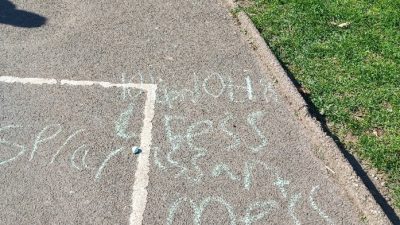
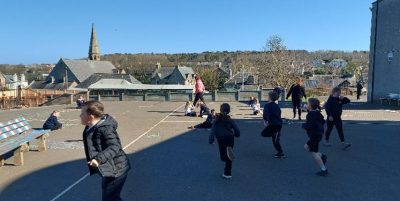
One of my standout moments outdoors was watching a fabulous literacy activity in action. In pairs, children were working together with word lists and chalk; one child read the word, ran over to their partner, and dictated it, and then the partner wrote the word on the playground before they switched roles. This “word relay” was joyous as it was full of movement, collaboration, excitement, and fun. Beneath that joy was a rich seam of learning: reading, writing, speaking, and listening, problem-solving, memory, motor skills, and important social and emotional development. It was a powerful reminder that learning doesn’t always need to involve sitting quietly at desks; in fact, for many of our children, it absolutely shouldn’t!
What’s also particularly impressive is the school’s commitment to empowerment and distributed leadership, which is genuinely helping to drive their vision for play pedagogy forward. A number of working parties have been established, including those focusing on Play Pedagogy, the UNCRC, Outdoor Learning, and Reading. These groups have been given the time and trust to meet regularly, reflect, and take forward ideas, and this has had a real impact on practice across the school. The play and outdoor learning group, for example, have led the way with the development of loose parts provision both indoors and outdoors, helping to enrich the environments and widen the scope for child-led exploration and creativity. It’s a clear sign of a school culture that values agency, collaboration, and shared ownership, a brilliant example of what distributed leadership can look like in action.
Mr Maunder and Mrs Hiroz are doing a fantastic job of embedding play pedagogy across the school, clearly understanding that although play evolves as children grow older, it never loses its importance. The pedagogical thinking at Eyemouth is spot on, with Mr Maunder carefully considering how to keep play meaningful and relevant for older children while ensuring curricular goals are still met. Eyemouth Primary has struck a lovely balance between child-led play and adult-initiated learning, something Fisher (2016) highlights as crucial for effective practice. Their sensitive interactions, skilled questioning, and thoughtfully designed environments all combine to create conditions for deep, meaningful learning. They’ve already gathered excellent evidence for the Play Pedagogy Award and, although they’re still in the implementation phase, the positive impact is clearly evident.
Their approach is deeply Froebelian too, recognising play as the way children naturally explore, understand, and connect with their world. Froebel believed that play is the highest form of learning, and at Eyemouth you can clearly see this belief in action. The adults observe and guide rather than direct or dominate, providing children with the freedom and space they need, while offering support exactly when required.
Eyemouth is currently in the implementation stage of the Play Pedagogy Award, and the progress they’ve made so far is amazing. They’ve done a fantastic job bringing parents along on their journey, many of whom are former pupils themselves, and who now appreciate just how positively education has changed since their own school days.
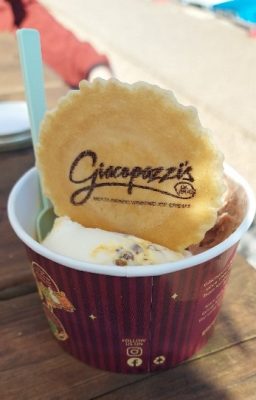
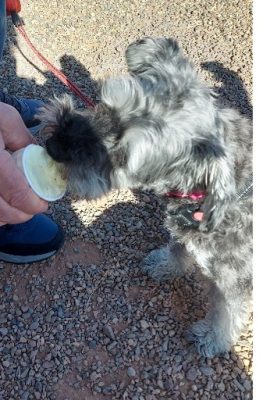
Of course, no great day would be complete without a wee treat! Taking Mrs Hiroz’s recommendation, I stopped off at the famous ice cream shop by the harbour. I can happily confirm that the Kinder Bueno ice cream was absolutely delicious, and my wee dog Lottie was delighted to discover there was even a special dog-friendly scoop just for her.
Thanks for a wonderful visit, Eyemouth Primary, I can’t wait to see the next steps of your play journey. Keep up the brilliant work!





